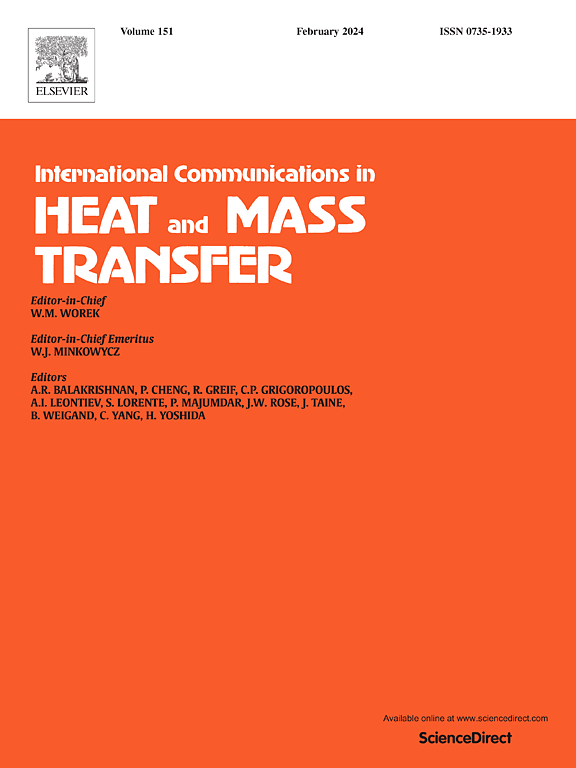Effect of channel thickness on the particle diffusion and permeability of carbon nanotubes a membrane in reverse electrodialysis process using molecular dynamics simulation
IF 6.4
2区 工程技术
Q1 MECHANICS
International Communications in Heat and Mass Transfer
Pub Date : 2025-05-31
DOI:10.1016/j.icheatmasstransfer.2025.109155
引用次数: 0
Abstract
Adopting innovative technology and solutions is critical for ensuring clean water. Several methods may be used to remove salts from water. They may be divided into two categories: membranes and heat. Reverse electrodialysis, which uses a membrane, is an efficient way of separating substances. Prior research investigated system-level factors, but the nanoscale mechanisms that drive ion and water penetration across membranes were poorly understood. This study closed a research gap by investigating the influence of carbon nanotube membrane thickness on particle mobility and fluid dynamics in reverse electrodialysis systems. The research is contributed to the enhancement of energy conversion efficiency and membrane performance in reverse electrodialysis systems by offering a comprehensive understanding of the influence of channel thickness on particle transport and selectivity through the carbon nanotube membrane. Molecular dynamics simulations using the LAMMPS software package are conducted to examine the effect of carbon nanotube thickness variation (1-layer vs 2-layer) on fluid flow, ionic current, hydrogen bonding, and fluid density. To the findings, increasing the thickness of a carbon nanotube from one layer to two layers decreases the fluid flow rate to 203.79 atoms/ns and the current from 5.31 e/ns to 5.15 e/ns. Additionally, the number of broken hydrogen bonds decreases from 116 to 105, indicating decreased permeability and increased stability of the hydrogen-bonding network. In addition to offering useful information for the construction of more effective and selective membranes in renewable energy applications, these results provided a molecular understanding of how carbon nanotube thickness affected reverse electrodialysis effectiveness.
利用分子动力学模拟研究了反电渗析过程中通道厚度对碳纳米管膜颗粒扩散和渗透性的影响
采用创新技术和解决方案对于确保清洁用水至关重要。有几种方法可以用来去除水中的盐。它们可以分为两类:膜和热。使用膜的反电渗析是一种有效的物质分离方法。先前的研究研究了系统级的因素,但对驱动离子和水穿过膜的纳米级机制知之甚少。本研究通过研究碳纳米管膜厚度对反向电渗析系统中颗粒迁移率和流体动力学的影响,填补了研究空白。该研究通过全面了解通道厚度对碳纳米管膜中颗粒传输和选择性的影响,有助于提高反电渗析系统的能量转换效率和膜性能。利用LAMMPS软件进行了分子动力学模拟,研究了碳纳米管厚度变化(1层vs 2层)对流体流动、离子电流、氢键和流体密度的影响。研究发现,当碳纳米管厚度由一层增加到两层时,流体流速降至203.79原子/ns,电流从5.31 e/ns降至5.15 e/ns。此外,断裂的氢键数从116个减少到105个,表明氢键网络的渗透性降低,稳定性提高。除了为在可再生能源应用中构建更有效和更有选择性的膜提供有用的信息外,这些结果还提供了碳纳米管厚度如何影响反向电渗析效率的分子理解。
本文章由计算机程序翻译,如有差异,请以英文原文为准。
求助全文
约1分钟内获得全文
求助全文
来源期刊
CiteScore
11.00
自引率
10.00%
发文量
648
审稿时长
32 days
期刊介绍:
International Communications in Heat and Mass Transfer serves as a world forum for the rapid dissemination of new ideas, new measurement techniques, preliminary findings of ongoing investigations, discussions, and criticisms in the field of heat and mass transfer. Two types of manuscript will be considered for publication: communications (short reports of new work or discussions of work which has already been published) and summaries (abstracts of reports, theses or manuscripts which are too long for publication in full). Together with its companion publication, International Journal of Heat and Mass Transfer, with which it shares the same Board of Editors, this journal is read by research workers and engineers throughout the world.

 求助内容:
求助内容: 应助结果提醒方式:
应助结果提醒方式:


